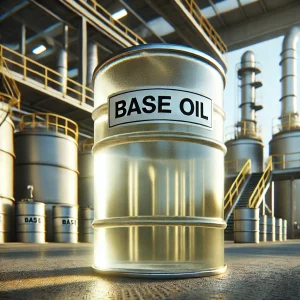Base oil is a primary component in lubricants, including motor oils, hydraulic oils, and greases. It constitutes about 70-90% of the final lubricant product, with the remainder being additives that enhance performance characteristics like viscosity, stability, and anti-wear properties.
Base oils are the backbone of lubricant formulation, directly impacting the performance, longevity, and environmental footprint of the final product. The ongoing development in base oil technology continues to push the boundaries of what lubricants can achieve in various industries.
Types of Base Oils
Mineral Base Oils:
Derived from refining crude oil, mineral base oils are the most commonly used type. They are categorized into three groups based on the refining process and the quality of the oil:
Group I: Produced through solvent refining, these are the least refined and contain more impurities.
Production: These are produced using solvent extraction, which removes certain components from the crude oil.
Characteristics: They have a higher level of impurities, such as sulfur and a
romatics, and generally exhibit lower performance characteristics. They have a lower viscosity index (VI), meaning their viscosity changes more with temperature.
Usage: Often used in applications where cost is a significant factor, and the performance demands are moderate.
Group II: Hydrotreated to remove impurities, offering better performance and oxidation stability.
Production: These oils undergo hydrocracking, a process that uses hydrogen to remove impurities like sulfur, nitrogen, and unsaturated hydrocarbons.
Characteristics: Group II oils have better oxidation stability, lower sulfur content, and a higher viscosity index than Group I oils. This makes them more suitable for modern engines and higher-performance applications.
Usage: Commonly used in automotive lubricants and industrial applications where better stability and longevity are required.
Group III: Highly refined using hydrocracking, these have improved viscosity and stability. Sometimes called “synthetic” in marketing, though they are still derived from crude oil.
Production: These are produced through severe hydrocracking and are highly refined, making them more stable and consistent.
Characteristics: Group III oils have the highest viscosity index among mineral oils, providing better performance across a wide temperature range. They also exhibit superior oxidation stability.
Usage: Sometimes marketed as synthetic, Group III oils are used in high-performance lubricants, including some synthetic motor oils.
Synthetic Base Oils:
Polyalphaolefins (PAO)
These are fully synthetic and offer superior performance, including excellent low-temperature properties and high thermal stability.
Production: PAOs are produced by polymerizing alpha-olefins, which are derived from ethylene. This process allows for precise control over molecular structure.
Characteristics: PAOs are known for their excellent low-temperature fluidity, high viscosity index, and resistance to oxidation and thermal breakdown. They also have lower volatility, reducing oil consumption.
Usage: Widely used in high-performance automotive and industrial lubricants, PAOs are especially valued in extreme temperature environments.
Esters
Also synthetic, these have excellent lubrication properties and are often used in high-performance applications.
Production: Esters are synthesized by reacting an alcohol with a carboxylic acid, creating a molecule with excellent lubrication properties.
Characteristics: Esters provide superior high-temperature stability, excellent lubrication, and are naturally polar, which means they adhere well to metal surfaces. They also have good biodegradability.
Usage: Often used in aviation lubricants, racing oils, and environmentally sensitive applications.
Polyalkylene Glycols (PAG)
Production: PAGs are made by polymerizing alkylene oxides, resulting in a product that is both water-soluble and oil-soluble, depending on the formulation.
Characteristics: PAGs offer excellent lubricity, thermal stability, and low volatility. They also resist sludge and varnish formation.
Usage: Commonly used in refrigeration compressor lubricants and hydraulic fluids, especially where water solubility is advantageous.
Biodegradable/Plant-based Oils:
Derived from natural sources like vegetable oils, these are environmentally friendly and used where biodegradability is important.
Production: Typically produced by refining oils from crops like soybeans, canola, or palm, sometimes enhanced through chemical processes to improve their performance characteristics.
Characteristics: Natural base oils are biodegradable, making them environmentally friendly. However, they may have limitations in terms of thermal stability and oxidation resistance compared to synthetic oils.
Usage: Used in environmentally sensitive areas, such as marine environments, forestry, and agriculture.
Base Oil Selection criteria
Viscosity Index: A higher VI indicates that the oil will maintain its viscosity over a broader temperature range. This is crucial for applications that operate under varying temperatures.
Oxidation Stability: Oils that resist oxidation will last longer and maintain their performance over time, reducing the need for frequent oil changes.
Thermal Stability: Important in high-temperature environments, where the oil must resist breaking down under heat.
Volatility: Low volatility is desirable, especially in engine oils, as it reduces oil consumption and emissions.
Compatibility: The base oil must be compatible with the additives and the materials in the machinery (e.g., seals, gaskets).
Environmental Impact: In applications where spillage or leakage is a concern, biodegradable oils may be preferred to minimize environmental harm.
Applications of Base Oils
Automotive Lubricants: Base oils are used in engine oils, transmission fluids, and greases. The choice of base oil affects fuel efficiency, engine protection, and oil change intervals.
Industrial Lubricants: Used in hydraulic systems, compressors, gearboxes, and turbines, the base oil’s properties are crucial for machinery reliability and efficiency.
Marine and Aviation: These sectors require lubricants with excellent thermal stability, oxidation resistance, and performance under extreme conditions.
Specialty Applications: Base oils are also used in applications like food-grade lubricants, where non-toxicity and safety are paramount, and in electrical insulating oils, where dielectric properties are critical.



